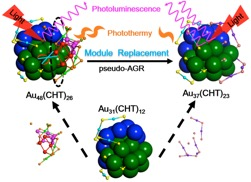Jul 6 2020
A collaborative team, including Prof. WU Zhikun’s group from the Institute of Solid State Physics, Hefei Institutes of Physical Science and CAS member YANG’s Jinlong group from the University of Science and Technology of China, has achieved continuous advances in pseudo-anti-galvanic reaction research.
 Module replacement process and its influences on photothermy and photoluminescence (left), cover image (right). Image Credit: XIA Nan.
Module replacement process and its influences on photothermy and photoluminescence (left), cover image (right). Image Credit: XIA Nan.
The related studies have been published in Acta Chimica Sinica and Journal of the American Chemical Society, respectively.
Named after Italian scientist Luigi Galvani (1737–1798), the galvanic reaction (GR) is one which a noble-metal cation is spontaneously reduced by a less noble metal in the solution.
WU’s group hypothesized and confirmed the opposite GR in 2012. The team discovered that the metal ions were reduced by more noble metals as the size of the metal decreased, and termed it as anti-galvanic reaction (AGR). Then, they performed a series of studies on the mechanisms and applications of AGR.
They recently discovered that metal nanoclusters were able to react with the same metal complexes (ions), which differed from GR or AGR. They named this new reaction pseudo-anti-galvanic reaction (or Pseudo-AGR).
As soon as AGR was reported, it was recognized as an exclusive method to tune the metal structure at the nanoscale by experts and collaborators in the field. But the researchers are yet to explore the potential of Pseudo-AGR.
Firstly, the above outcomes of the study on Pseudo-AGR opened the door for further studies on accurate modulation of the structure of nanoparticles in a controlled manner, which is a difficult and exciting task.
Researchers have recently achieved customization of single or few metal-atom metal nanoparticles with the remnant structure remaining untouched. However, module replacement (MR), which involves using more than three net metal atoms to achieve the local structural replacement, has not been achieved yet.
For the first time, the collaborative team recently achieved the MR of the Au48(CHT)26 (CHT: cyclohexanethiolate) nanoclusters through a Pseudo-AGR technique and achieved another new type of Au37(CHT)23 nanoclusters.
The MR product Au37(CHT)23 and its predecessor Au48(CHT)26 share a similar Au31(CHT)12 unit, but the former varied from the latter in terms of the remnant section (Au6(CHT)11 vs Au17(CHT)14).
One interesting fact was that the MR weakened the photoluminescence but fortified the photothermy in this study. This indicates that the two effects were balanced and could be at least partly transformed to each other for nanoclusters.
This study has crucial implications for adapting the structures in future and to gain in-depth insights into the interactions between different properties as well.
Secondly, the Pseudo-AGR process had also played a crucial role in the detection of structural oscillation in nanoparticles. Oscillation is a common phenomenon that occurs in different systems in nature, ranging from small atoms to large celestial bodies. But it has been impossible to achieve atomically accurate observation of structural oscillation in nanoparticles.
WU’s research group produced a pair of nanocluster isomers Au28i and Au28ii at the same time through a Pseudo-AGR process.
It must be noted that these isomers are the fourth pair of structural isomers produced to date. The first and second pairs of structural isomers were also produced by WU’s research group.
An intriguing fact is the structures of both the isomers could oscillate for a minimum of 10 cycles, induced by crystallization and dissolution processes.
In addition, the conversion from Au28ii to Au28i depended on the dielectric constant of the solvent and exhibited deuteration effect: the rate at which structural transformation occurred was directly proportional to the dielectric constant. Despite both having identical metal kernel but distinct outer staples, Au28ii exhibited improved photoluminescence than Au28i.
The extensive emission found in a previous study by WU’s research group was explained by the rigid structure on the shell. The oscillation between two isomers with a very high difference in fluorescence might have prospective applications in sensing, conversion, etc.
Both the studies were financially supported by the National Natural Science Foundation of China, the Natural Science Foundation of Anhui Province, the CAS/SAFEA International Partnership Program for Creative Research Teams, and the CASHIPS Director’s Fund.
Journal Reference:
Xia, N., et al. (2020) Structural Oscillation Revealed in Gold Nanoparticles. Journal of the American Chemical Society. doi.org/10.1021/jacs.0c02117.